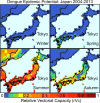Dissecting Japan's Dengue Outbreak in 2014
- PMID: 26711518
- PMCID: PMC4751952
- DOI: 10.4269/ajtmh.15-0468
Dissecting Japan's Dengue Outbreak in 2014
Abstract
Despite Japan's temperate climate, a dengue outbreak occurred in Tokyo for the first time in over 70 years in 2014. We dissected this dengue outbreak based on phylogenetic analysis, travel interconnectivity, and environmental drivers for dengue epidemics. Comparing the available dengue virus 1 (DENV1) E gene sequence from this outbreak with 3,282 unique DENV1 sequences in National Center for Biotechnology Information suggested that the DENV might have been imported from China, Indonesia, Singapore, or Vietnam. With travelers arriving into Japan, Guangzhou (China) may have been the source of DENV introduction, given that Guangzhou also reported a large-scale dengue outbreak in 2014. Coinciding with the 2014 outbreak, Tokyo's climate conditions permitted the amplification of Aedes vectors and the annual peak of vectorial capacity. Given suitable vectors and climate conditions in addition to increasing interconnectivity with endemic areas of Asia, Tokyo's 2014 outbreak did not come as a surprise and may foretell more to come.
© The American Society of Tropical Medicine and Hygiene.
Figures



Similar articles
-
The dengue preface to endemic in mainland China: the historical largest outbreak by Aedes albopictus in Guangzhou, 2014.Infect Dis Poverty. 2017 Sep 22;6(1):148. doi: 10.1186/s40249-017-0352-9. Infect Dis Poverty. 2017. PMID: 28934991 Free PMC article.
-
The interplay of climate, intervention and imported cases as determinants of the 2014 dengue outbreak in Guangzhou.PLoS Negl Trop Dis. 2017 Jun 22;11(6):e0005701. doi: 10.1371/journal.pntd.0005701. eCollection 2017 Jun. PLoS Negl Trop Dis. 2017. PMID: 28640895 Free PMC article.
-
The origin of dengue viruses caused the DF outbreak in Guangdong province, China, in 2006.Infect Genet Evol. 2011 Jul;11(5):1183-7. doi: 10.1016/j.meegid.2011.03.025. Epub 2011 Apr 5. Infect Genet Evol. 2011. PMID: 21473933
-
[An autochthonous outbreak of dengue type 1 in Tokyo, Japan 2014].Nihon Koshu Eisei Zasshi. 2015;62(5):238-50. doi: 10.11236/jph.62.5_238. Nihon Koshu Eisei Zasshi. 2015. PMID: 26118707 Japanese.
-
Phylogenetic analysis of dengue virus reveals the high relatedness between imported and local strains during the 2013 dengue outbreak in Yunnan, China: a retrospective analysis.BMC Infect Dis. 2015 Mar 21;15:142. doi: 10.1186/s12879-015-0908-x. BMC Infect Dis. 2015. PMID: 25885572 Free PMC article.
Cited by
-
Dengue Virus Infection in Aedes albopictus during the 2014 Autochthonous Dengue Outbreak in Tokyo Metropolis, Japan.Am J Trop Med Hyg. 2018 May;98(5):1460-1468. doi: 10.4269/ajtmh.17-0954. Epub 2018 Mar 15. Am J Trop Med Hyg. 2018. PMID: 29557338 Free PMC article.
-
A Prospective Study on the Impact and Out-of-Pocket Costs of Dengue Illness in International Travelers.Am J Trop Med Hyg. 2019 Jun;100(6):1525-1533. doi: 10.4269/ajtmh.18-0780. Am J Trop Med Hyg. 2019. PMID: 30994088 Free PMC article.
-
The use and reporting of airline passenger data for infectious disease modelling: a systematic review.Euro Surveill. 2019 Aug;24(31):1800216. doi: 10.2807/1560-7917.ES.2019.24.31.1800216. Euro Surveill. 2019. PMID: 31387671 Free PMC article.
-
Assessing dengue control in Tokyo, 2014.PLoS Negl Trop Dis. 2019 Jun 21;13(6):e0007468. doi: 10.1371/journal.pntd.0007468. eCollection 2019 Jun. PLoS Negl Trop Dis. 2019. PMID: 31226116 Free PMC article.
-
Zika Virus Potential Vectors among Aedes Mosquitoes from Hokkaido, Northern Japan: Implications for Potential Emergence of Zika Disease.Pathogens. 2021 Jul 24;10(8):938. doi: 10.3390/pathogens10080938. Pathogens. 2021. PMID: 34451402 Free PMC article.
References
-
- Wilder-Smith A, Quam M, Sessions O, Rocklov J, Liu-Helmersson J, Franco L, Khan K. The 2012 dengue outbreak in Madeira: exploring the origins. Euro Surveill. 2014;19:20718. - PubMed
-
- Japanese Ministry of Health Labour and Welfare For Domestic Infection Cases of Dengue Fever (38th Report) 2014. http://www.mhlw.go.jp/bunya/kenkou/kekkaku-kansenshou19/dl/20141031-01.pdf Available at. Accessed January 21, 2015.
Publication types
MeSH terms
LinkOut - more resources
Full Text Sources
Other Literature Sources
Medical

